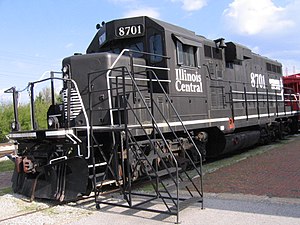This article needs additional citations for verification .(August 2016) |
| EMD GP11 | |||||||||||
|---|---|---|---|---|---|---|---|---|---|---|---|
 An Illinois Central GP11 now on permanent display in downtown Carbondale, Illinois. This is the second GP11 rebuilt by ICG's shops in Paducah, Ky The first GP11 was numbered 8301. After this unit was rebuilt the 8700-series was created for the GP11s. It was intended that 8301 would be renumbered 8700, but that never happened. | |||||||||||
| |||||||||||
| |||||||||||
The EMD GP11 is a four-axle diesel locomotive rebuilt by the Illinois Central Railroad's Paducah shops. It is very similar in appearance to the GP8 and GP10.
Contents
The Illinois Central Railroad began its GP11 rebuilding program in 1978. All units were rebuilt from recycled EMD GP7, GP9 or GP18 parts. Spotting features are an angled cab, exterior paper air filter, new air intake for the traction motors and four exhaust stacks. Internally they had Dash 2 solid state electrical equipment.
